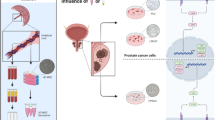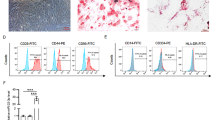Abstract
Overexpression of basic fibroblast growth factor (bFGF) has been implicated in the pathogenesis of benign prostatic hyperplasia (BPH) and bFGF has been considered to be a promising therapy target for BPH. RNA interference (RNAi) based therapeutic approaches hold promise for the treatment of a variety of diseases. However, RNAi experiments have seldom been performed in human prostatic stromal cells (PrSCs). In the present study, we tranfected adenovirus type 5 vector mediated small hairpin RNA (shRNA) against human bFGF mRNA (Ad-sh-bFGF) to examine the proliferation and apoptosis effects on cultured human primary PrSCs. The gene-silencing effect of shRNA was evaluated by western blot. Cell proliferation was determined by MTT assays. Cell apoptosis was analyzed by flow cytometry and detection of caspase-3 activity. The effect of Ad-sh-bFGF on Bcl-2 gene expression was also examined. Adenovirus type 5 can efficiently delivered shRNA against bFGF into to PrSCs and the level of protein was depressed significantly in cells infected by Ad-sh-bFGF, approximately 50% lower than those cells infected by adenovirus-delivered nonsense shRNA (P < 0.01). Moreover, Ad-sh-bFGF is able to induce apoptosis and inhibit proliferation of cultured human primary PrSCs significantly (P < 0.01). Bcl-2 protein expression was markedly inhibited by transfection with Ad-sh-bFGF. In conclusion, our findings suggest that RNAi delivered via an adenovirus vector offers a prospect of improvement in treatment of BPH and bFGF is a potential target worth exploiting in BPH.



Similar content being viewed by others
References
Meigs JB, Mohr B, Barry MJ, Collins MM, McKinlay JB (2001) Risk factors for clinical benign prostatic hyperplasia in a community-based population of healthy aging men. J Clin Epidemiol 54:935–944
Donovan JL, Kay HE, Peters TJ, Abrams P, Coast J, Matos-Ferreira A, Rentzhog L, Bosch JL, Nordling J, Gajewski JB, Barbalias G, Schick E, Silva MM, Nissenkorn I, de la Rosette JJ (1997) Using the ICSOoL to measure the impact of lower urinary tract symptoms on quality of life: evidence from the ICS-`BPH’ Study. International Continence Society—Benign Prostatic Hyperplasia. Br J Urol 80:712–721
Chapple CR (1999) BHP Disease Management. Introduction and concluding remarks. Eur Urol 36(Suppl 3):1–6
Jensen KM-E (1989) Clinical evaluation of routine urodynamic investigations in prostatism. Neurourol Urodynam 8:545–578
Kaplan SA (2003) Medical therapy for asymptomatic men with benign prostatic hyperplasia: primum non nocere. Urology 62:784–785
Gormley GJ, Stoner E, Bruskewitz RC, Imperato-McGinley J, Walsh PC, McConnell JD, Andriole GL, Geller J, Bracken BR, Tenover JS (1992) The effect of finasteride in men with benign prostatic hyperplasia. The Finasteride Study Group. N Engl J Med 327:1185–1191
Lepor H (2005) Pathophysiology of benign prostatic hyperplasia in the aging male population. Rev Urol 7(Suppl 4):S3–S12
Lucia MS, Lambert JR (2008) Growth factors in benign prostatic hyperplasia: basic science implications. Curr Urol Rep 9:272–278
Shimabukuro Y, Ueda M, Ozasa M, Anzai J, Takedachi M, Yanagita M, Ito M, Hashikawa T, Yamada S, Murakami S (2009) Fibroblast growth factor-2 regulates the cell function of human dental pulp cells. J Endod 35:1529–1535
Bikfalvi A, Klein S, Pintucci G, Rifkin DB (1997) Biological roles of fibroblast growth factor-2. Endocr Rev 18:26–45
Mori H, Maki M, Oishi K, Jaye M, Igarashi K, Yoshida O, Hatanaka M (1990) Increased expression of genes for basic fibroblast growth factor and transforming growth factor type beta 2 in human benign prostatic hyperplasia. Prostate 16:71–80
Giri D, Ittmann M (2001) Interleukin-8 is a paracrine inducer of fibroblast growth factor 2, a stromal and epithelial growth factor in benign prostatic hyperplasia. Am J Pathol 159:139–147
Dai Y, Qiao L, Chan KW, Yang M, Ye J, Zhang R, Ma J, Zou B, Lam CS, Wang J, Pang R, Tan VP, Lan HY, Wong BC (2009) Adenovirus-mediated down-regulation of X-linked inhibitor of apoptosis protein inhibits colon cancer. Mol Cancer Ther 8:2762–2770
Yue W, Abe K, Brouwer KL (2009) Knocking down breast cancer resistance protein (Bcrp) by adenoviral vector-mediated RNA interference (RNAi) in sandwich-cultured rat hepatocytes: a novel tool to assess the contribution of Bcrp to drug biliary excretion. Mol Pharm 6:134–143
Chu L, Gu J, Sun L, Qian Q, Qian C, Liu X (2008) Oncolytic adenovirus-mediated shRNA against Apollon inhibits tumor cell growth and enhances antitumor effect of 5-fluorouracil. Gene Ther 15:484–494
Cengiz E, Karaca B, Kucukzeybek Y, Gorumlu G, Gul MK, Erten C, Atmaca H, Uzunoglu S, Karabulut B, Sanli UA, Uslu R (2010) Overcoming drug resistance in hormone and drug-refractory prostate cancer cell line, PC-3 by docetaxel and gossypol combination. Mol Biol Rep 37:1269–1277
Zhang HB, Wu J, Xian J, Pei L, Wang J (2008) Two approaches to construct mammalian expression vector of shRNA to reduce expression, replication of HBV in vitro. Mol Biol Rep 35:465–472
Chen L, Cheng X, Tian L, Yang T, Hermann S, Zhou D (2009) Inhibition of P-glycoprotein over-expression by shRNA-mdr1b in rat astrocytes. Neurochem Res 34:411–417
Paddison PJ (2008) RNA interference in mammalian cell systems. Curr Top Microbiol Immunol 320:1–19
Fire A, Xu S, Montgomery MK, Kostas SA, Driver SE, Mello CC (1998) Potent and specific genetic interference by double-stranded RNA in Caenorhabditis elegans. Nature 391:806–811
Elbashir SM, Harborth J, Weber K, Tuschl T (2002) Analysis of gene function in somatic mammalian cells using small interfering RNAs. Methods 26:199–213
Couzin J (2002) Breakthrough of the year. Small RNAs make big splash. Science 298:2296–2297
Wang X, Chen Y, Lv L, Chen J (2010) Inhibition of latent transforming growth factor-beta1 activation by lentivirus-mediated short hairpin RNA targeting the CD36 gene in NR8383 cells. Mol Biol Rep 37:1649–1655
Liu X, Yang J, Shang F, Hong C, Guo W, Wang B, Zheng Q (2009) Silencing GIRK4 expression in human atrial myocytes by adenovirus-delivered small hairpin RNA. Mol Biol Rep 36:1345–1352
Chen Z, Liang K, Xie M, Wang X, Lü Q, Zhang J (2009) Novel ultrasound-targeted microbubble destruction mediated short hairpin RNA plasmid transfection targeting survivin inhibits gene expression and induces apoptosis of HeLa cells. Mol Biol Rep 36:2059–2067
Burchill SA, Westwood G (2002) Mechanism of basic fibroblast growth factor-induced cell death. Apoptosis 7:5–12
Hsuan SL, Klintworth HM, Xia Z (2006) Basic fibroblast growth factor protects against rotenone-induced dopaminergic cell death through activation of extracellular signal-regulated kinases 1/2 and phosphatidylinositol-3 kinase pathways. J Neurosci 26:4481–4491
Miho Y, Kouroku Y, Fujita E, Mukasa T, Urase K, Kasahara T, Isoai A, Momoi MY, Momoi T (1999) bFGF inhibits the activation of caspase-3 and apoptosis of P19 embryonal carcinoma cells during neuronal differentiation. Cell Death Differ 6:463–470
Zhang Z, Duan L, Du X, Ma H, Park I, Lee C, Zhang J, Shi J (2008) The proliferative effect of estradiol on human prostate stromal cells is mediated through activation of ERK. Prostate 68:508–516
Davidson BL, Hilfinger JM, Beer SJ (1997) Extended release of adenovirus from polymer microspheres: potential use in gene therapy for brain tumors. Adv Drug Deliv Rev 27:59–66
Author information
Authors and Affiliations
Corresponding author
Electronic supplementary material
Below is the link to the electronic supplementary material.
Supplementary Fig. 1
The sequencing oscillogram of adenovirus vector (type 5, ΔE1/E3) delivery of shRNA targeting bFGF. (TIFF 297 kb)
Supplementary Fig. 2a
Primary cultured PrPCs were infected with Ad-EGFP for 48 h and observed through a fluorescence microscope: a Light field (Original magnification × 200) (TIFF 2461 kb)
Supplementary Fig. 2b
Primary cultured PrPCs were infected with Ad-EGFP for 48 h and observed through a fluorescence microscope: b Fluorescence field (Original magnification × 200) (TIFF 2459 kb)
Rights and permissions
About this article
Cite this article
Wang, K., Cheng, L., Liang, Y. et al. Adenovirus-mediated delivery of shRNA against bFGF mRNA suppresses growth of cultured human primary prostatic stromal cells. Mol Biol Rep 38, 971–976 (2011). https://doi.org/10.1007/s11033-010-0191-2
Received:
Accepted:
Published:
Issue Date:
DOI: https://doi.org/10.1007/s11033-010-0191-2




